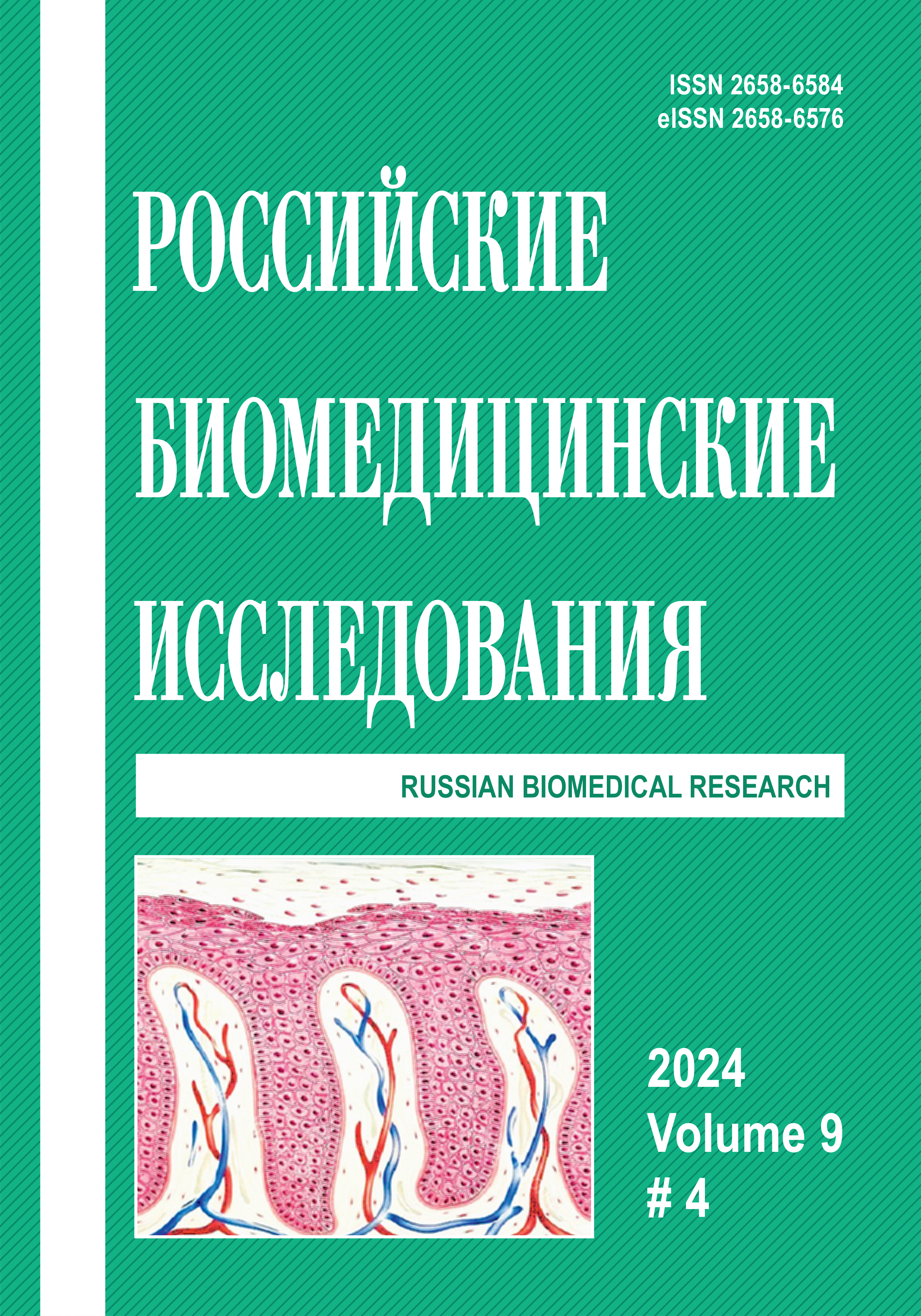CHARACTERISTICS OF THE TASTE SENSITIVITY OF THE TONGUE IN ELDERLY PEOPLE WHO HAVE SUFFERED COVID-19
Abstract
Introduction. Many patients who have had COVID-19 report taste disorders that occur during the height of the disease, and sometimes persist for a certain time after recovery. Therefore, the study of taste sensitivity indicators in older people who have suffered a new coronavirus infection COVID-19 seems relevant for understanding the pathophysiological processes occurring in the human body. Purpose of the study: was to study the characteristics of the taste sensitivity of the tongue in elderly people who have suffered a new coronavirus infection COVID-19, based on a study of the thresholds of taste sensitivity of the tongue and electrogustometry. Materials and methods. The thresholds of taste sensitivity of the tongue, as well as indicators of electrogustometry of the tongue, were studied in 89 elderly people, who were divided into 2 study groups. Group 1 included 37 patients without pronounced psychosomatic pathology who did not suffer from the new coronavirus infection COVID-19. The 2nd main group of the study included 52 patients who underwent COVID-19 6 to 9 months ago. The patients of the 2 groups were divided into 2 subgroups, taking into account the presence or absence of complaints of impaired taste sensitivity during the course of COVID-19 disease. The results of the study. It was found that people who had a new coronavirus infection COVID-19, regardless of whether they had complaints of taste sensitivity disorders during the disease or not, 6 to 9 months after the disease, they had no differences in electrogustometry indicators. In patients who did not complain of taste disorders during the COVID-19 period, only an increase in the threshold of taste sensitivity of the tongue to salty was noted in the post-ovoid period, while in patients who complained of taste disorders during the COVID-19 disease, there was a significant increase in the thresholds of taste sensitivity of the tongue to all types of stimuli, although such an indicator for gorky was within the reference values. Conclusion. The data obtained indicate the peculiarities of the functioning of the taste analyzer in people who have suffered a new coronavirus infection COVID-19, and also indicate that an increase in the thresholds of taste sensitivity of the tongue in elderly patients may hinder the formation of a feeling of satiety and contribute to maintaining the desire to eat during the day, leading to difficulties with the regulation of diet therapy, an important component of the complex treatment of various psychosomatic pathologies.
References
Wang Z., Lorenzi J.C.C., Muecksch F., Finkin S., Viant C., Gaebler C., Cipolla M., Hoffman H.-H., Oliveira T.Y., Oren D.A. Enhanced SARS-CoV-2 Neutralization by Secretory IgA in vitro. bioRxiv. 2020. DOI: 10.1101/2020.09.09.288555.
Axe A., Varghese R., Bosma M., Kitson N., Bradshaw D. Dental health professional recommendation and consumer habits in denture cleansing. The Journal Of Prosthetic Dentistry. 2016;115(2):183–188. DOI: 10.1016/j.prosdent.2015.08.007.
Солдатова Л.Н., Иорданишвили А.К., Ермолаева Л.А. Пародонтологический статус и возможности его оптимизации у пожилых пациентов. Успехи геронтологии. 2023;28(1):83–8. DOI: 10.34922/AE.2023.36.6.010.
Швецов М.М., Малышев М.Е., Иорданишвили А.К. Стоматологические последствия новой коронавирусной инфекции и возможности их устранения. Здоровье — основа человеческого потенциала: проблемы и пути решения. 2023;18(2):12–13.
Федорович Л.Р., Иорданишвили А.К., Тегза Н.В. Гиалуроновая кислота как один из методов лечения постковидного синдрома в полости рта. Теоретические и практические вопросы клинической стоматологии. СПб.; 2023:110–113.
Швецов М.М., Малышев М.Е., Иорданишвили А.К. Особенности дентальной имплантации у лиц с последствиями новой коронавирусной инфекции COVID-19. II ежегодная Научная сессия ФГБОУ ВО ЧГМА. Чита; 2023:167–169.
Иорданишвили А.К., Малышев М.Е., Швецов М.М. Коррекция иммунных дисфункций в полости рта у людей, перенесших новую коронавирусную инфекцию COVID-19. Институт стоматологии. 2022;4(97):50–51.
Швецов М.М., Малышев М.Е., Иорданишвили А.К. Возможности отечественных индивидуальных средств ухода за полостью рта в устранении стоматологических проявлений последствий новой коронавирусной инфекции COVID-19. Медицинский алфавит. 2022;2:25–26. DOI: 10.33667/2078-5631-2022-2-25-29.
Малышев М.Е., Швецов М.М., Иорданишвили А.К. Особенности ухода за полостью рта при лечении пародонтита у пациентов, перенесших новую коронавирусную инфекцию COVID-19. Медицинский алфавит. 2022;3(22):21–26. DOI: 10.33667/2078-5631-2022-22-21-26.
Курляндский В.Ю., Хватова В.А., Воложин А.И., Лавочник М.И. Методы исследования в ортопедической стоматологии. Ташкент: Медицина; 1973.
Иорданишвили А.К. Физиология и патофизиология жевательно-речевого аппарата. СПб.: Человек; 2016.
Griffin S.O., Jones J.A., Brunson D., Griffin P.M., Bailey W.D. Burden of oral disease among older adults and implications for public health priorities. American journal of public health. 2012;102(3):411–418. DOI: 10.2105/AJPH.2011.300362.
Иорданишвили А.К., Филиппова Е.В., Либих Д.А., Рыжак Г.А. Клинико-функциональное состояние слизистой оболочки полости рта и языка у людей старших возрастных групп. Институт стоматологии. 2012;4(57):80–81.
Бельских А.Н., Бельских О.А. Иорданишвили А.К. Хроническая болезнь почек: особенности стоматологической патологии. СПб.: Нордмедиздат; 2016.
Тытюк С.Ю., Иорданишвили А.К. Стоматологическое здоровье при хронических воспалительных заболеваниях кишечника. СПб.: Нордмедиздат; 2016.
Иорданишвили А.К. Гериатрическая стоматология. Руководство. СПб.: Человек; 2019.
Иорданишвили А.К. Геронтостоматология. Учебник. СПб.: Человек; 2022.
Hayflick L. New approaches to old age. Nature. 2000;403:365.
Copyright (c) 2024 Russian Biomedical Research

This work is licensed under a Creative Commons Attribution 4.0 International License.



